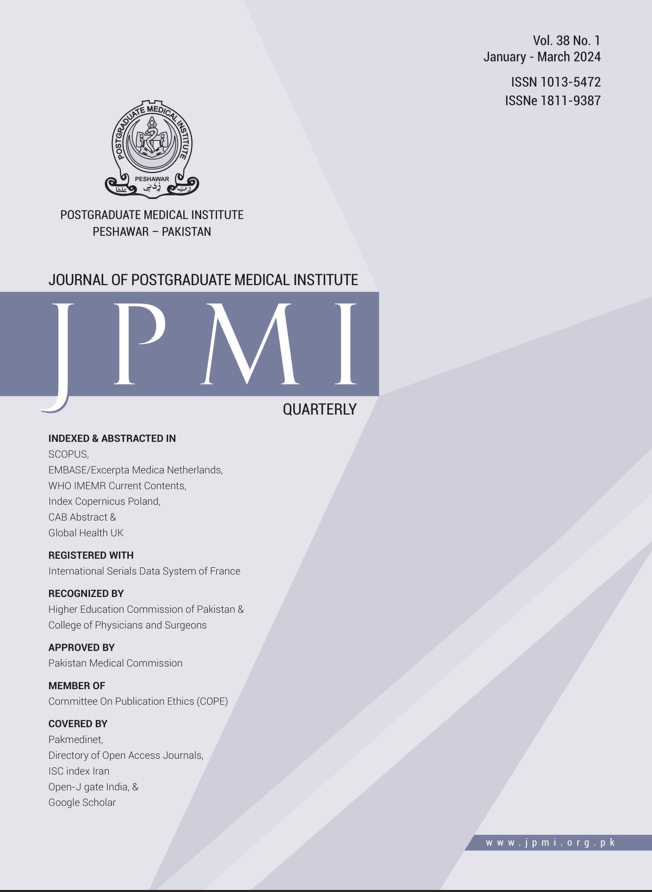DEVELOPMENT AND VALIDATION OF SCALE ON ACADEMIC STRESSORS IN COLLEGE STUDENTS: A FACTOR ANALYTICAL APPROACH
Main Article Content
Abstract
Objective:
To find out the experience and expression of academic stressors in college students and to develop a reliable and valid measure.
Methodology:
A sample of 244 college students with age range 15-20 (M = 17.38, SD = 1.22) were selected through the convenient sampling technique. Both boys and girls living in intact families, having no physical or psychological disorder studying in different government and private institutes of city Lahore were included in the study. A three-step model (item generation, expert validation, and pilot study) was used to develop the scale.
Results:
Descriptive statistics revealed n=97(39%) 1st year and 147 (61%) 2nd year students with highest number living in nuclear family system (n=150 (61%). Exploratory factor analysis using Principal Component factor analysis revealed two factors: sustaining performance and psychosocial stressors. The value of Kaiser-Meyer-Olkin was .87and the Bartlett test was 929.90 with p=0.000. Student Problem Checklist was used to establish the concurrent validity of the scale and was found to be r=.92. The internal consistency was 0.92 (p<0.001) and the test-retest reliability of ASS was r=.67 (p<0.001). Girls experienced more academic stressor (M=35.53,SD=19.43, p<0.001) as compared to boys (M=31.72,SD=13.45)
Conclusion:
The Academic Stressor Scale is an indigenous scale with established psychometrics that provides a depiction of academic stressors faced by Students in Pakistani culture.
Article Details
Work published in JPMI is licensed under a
Creative Commons Attribution-NonCommercial 2.0 Generic License.
Authors are permitted and encouraged to post their work online (e.g., in institutional repositories or on their website) prior to and during the submission process, as it can lead to productive exchanges, as well as earlier and greater citation of published work.
References
Pascoe MC, Hetrick SE, Parker AG. The impact of stress on students in secondary school and higher education. Int J Adolesc Youth. 2020; 25(1):104-112. DOI: 10.1080/02673843.2019.1596823.
Ribeiro ÍJS, Pereira R, Freire IV, de Oliveira BG, Casotti CA, Boery EN. Stress and quality of life among university students: A systematic literature review. Health Prof. Educ. 2017; 4(2): 70-7. DOI:10.1016/j.hpe.2017.03.002.
Masih PP, Gulrez NK. Age and gender differences on stress. Recent trends in human stress management. Global Vision Publishing House. 2006:97-104
Bennett T H, Holloway K R. Drug misuse among university students in the UK. Implications for prevention. Subst Use Misuse. 2014;49(4):448-55. DOI: 10.3109/10826084.2013.846378.
Busari AO. Evaluating the Relationship between Gender Age Depression and Academic Performance among Adolescents. J Educ. 2012;1(1):6-12.
Pedrelli P, Nyer M, Yeung A. College Students: Mental Health Problems and Treatment Considerations. Acad Psychiatry. 2015.39(5):503-11. DOI: 10.1007/s40596-014-0205-9.
Umbrin I, Shah S, Siddiqui S, Rehman S, Asad W, Ambreen U. Assessment of Level of Stress in Undergraduate Medical Students of a Private Medical College in Pakistan. Pak J Med Health Sci. 2022 Dec 11;16(10):495-98. DOI: 10.53350/pjmhs221610495.
Posselt JR, Lipson SK. Competition, anxiety, and depression in the college classroom: Variations by student identity and field of study. J Coll Stud Dev.2016; 57(8):973-89. DOI:10.1353/csd.2016.0094.
Skidmore C,Kaufman E, Crowell S. Substance Use Among College Students. Child Adolesc Psychiatr Clin. 2016; 25: 735-53. DOI.10.1016/j.chc.2016.06.004.
Shen FC, Liao KY, Abraham WT, Weng CY. Parental pressure and support toward Asian Americans’ self-efficacy, outcome expectations, and interests in stereotypical occupations: Living up to parental expectations and internalized stereotyping as mediators. J Counsel Psycho. 2014; 61(2):241-52. DOI: 10.1037/a0036219.
Bugaj TJ, Cranz A, Junne F, Erschens R, Herzog W, Nikendei C. Psychosocial burden in medical students and specific prevention strategies. Ment Health Prev. 2016; 4(1):24-30. DOI: 10.1016/j.mhp.2015.12.003.
Taylor J M. Psychometric analysis of the ten-item perceived stress scale. Psychol Assess. 2015. 27(1):90-101. DOI: 10.1037/a0038100.
Eisenberg D, Hunt J, Speer N. Mental health in American colleges and universities: Variation across student subgroups and across campuses. J Nerv Ment Dis. 2013;201(1):60–7. DOI: 10.1097/NMD.0b013e31827ab077.
Mahmood Z, Saleem S. Assessing psychological problems in University students in Pakistan: A psychometric study. FWU J Soc Sci. 2011;4(2):21-38.
Costello AB, Osborne J. Best Practices in Exploratory Factor Analysis Four Recommendations for Getting the Most from Your Analysis. Pract. Assess. Res. Evaluation. 2005;10(7):1-9. DOI: 10.7275/jyj1-4868.
DeVellis RF. Scale Development: Theory and Applications 4th ed. 2017. Sage Publications.
Yamamoto Y, Holloway S D. Parental expectations and children's academic performance in sociocultural context. Edu Psycho Rev.2010;22:189–214. DOI: 10.1007/s10648-010-9121-z.
Fitzsimmons-Craft EE, Karam AM, Monterubio GE, Taylor CB, Wilfley DE. Screening for Eating Disorders on College Campuses: a Review of the Recent Literature. Curr Psychiatry Rep. 2019;21(10):101. DOI: 10.1007/s11920-019-1093-1.
Radhika Kapur. Impact of Culture on Education. ResearchGate. 2018. Available from URL: https://www.researchgate.net/publication/323794724_Impact_of_Culture_on_Education
Reddy KJ, Menon KR, Thattil A. Academic Stress and its Sources Among University Students. Biomed Pharmacol J. 2018;11(1):531-7. DOI: 10.13005/bpj/1404.
Matingwina T. Health information dissemination among undergraduate students in Zimbabwe with particular reference to the National University of Science and Technology: a study in developing an integrated framework for health information dissemination. University of Cape Town, Library and Information Studies Centre (LISC). 2015. Available from URL: http://hdl.handle.net/11427/15574.
Heissel JA, Adam EK, Doleac JL, Figlio DL, Meer J. Testing, Stress and Performance: How Students Respond Physiologically to High-Stakes Testing. Edu Fin and Pol. 2021;16 (2):183–208. DOI: 10.1162/edfp_a_00306.
Shan C, Hussain M, Sargani GR. A mix-method investigation on acculturative stress among Pakistani students in China. PloS One. 2020;15(10):e0240103. DOI:10.1371/journal.pone.0240103
Margraf J, Zhang XC, Lavallee KL, Schneider S. Longitudinal prediction of positive and negative mental health in Germany, Russia, and China. PLoS One. 2020; 15(6):e0234997. DOI: 10.1371/journal.pone.0234997.
Lazarus R S. & Folkman S. Stress, appraisal and Coping. New York: Springer. 1984.
Binti Md. Noor NA, Abu Bakar R, Bit-Lian Y. Stress and coping strategies during clinical practices among degree nursing students of a private institution. Malaysian J Nursing. 2020;11(03):53–62. DOI: 10.31674/mjn.2020.v11i03.009.


